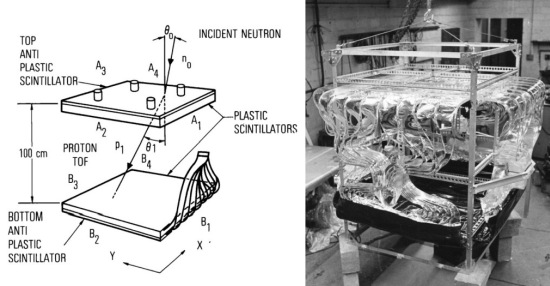Purpose of the flight and payload description
EOSCOR was the acronym of Extended Observation of Solar Cosmic Radiation, a balloon-borne detector for measuring solar flare neutrons in the energy range 20 to 150 MeV. The instrument was designed at the Case Western Reserve University during late 1970's decade to take advantage of several long durations balloon flight systems under development at the time.
In the scheme at left we can see a basic scheme of the EOSCOR III detector and a picture of the assembled system (click to enlarge).
EOSCOR was composed by two scintillators separated by a 1 meter time-of-flight (TOF) path. Neutrons incident on the detector produced protons via scatterings and interactions in the upper scintillator. TOF is then used to discriminate the slower moving proton recoils from the copious relativistic Compton electrons generated by the atmospheric and cosmic gamma-radiation. Complete protection against data contamination by charged particle induced events is provided by veto counters placed above the upper scintillator and below the lower scintillator. The energy loss in the upper scintillator and the proton's velocity (as determined from the TOF measurement) were combined to give the energy of the proton recoil. Solar neutron events were then characterized by an increase in the neutron counting rate over the atmospheric background, correlated in time with a flare. Since the gondola orientation and the position of the sun were known, the incident neutron energy could be determined from the measured proton energy by simple scattering kinematics.
Details of the balloon flight
Balloon launched on: 10/17/1979 at 14:17 utc
Launch site: Columbia Scientific Balloon Facility, Palestine, Texas, US
Balloon launched by: National Scientific Balloon Facility (NSBF)
Balloon manufacturer/size/composition: Zero Pressure Balloon Winzen 119.214 m3 (15.24 microns - Stratofilm) - SF217.48-060-NSCHR-02
Balloon serial number: W4.21-1-04
Flight identification number: 1177P
End of flight (L for landing time, W for last contact, otherwise termination time): 10/18/1979 at 15:09 utc
Balloon flight duration (F: time at float only, otherwise total flight time in d:days / h:hours or m:minutes - ): F 25 h 25 m
Landing site: 20 miles W of Columbia, Tennessee, US
Payload weight: 840 kgs
EOSCOR was launched at 14:17 utc on October 17, 1974 from NCAR balloon base of Palestine, Texas. The primary objective of this flight was to search for neutrons emitted during solar activity, particularly in conjunction with large flares. The flight was scheduled during turnaround in order to increase the time at float altitude thereby increasing the probability of observing a flare. The EOSCOR detector used on this flight was designed primarily for long duration Sky Anchor flights. Therefore, a secondary objective of this flight was an engineering one to test the gondola operation at altitude and to measure directly the background counting rate due to atmospheric neutrons.
Only C class flares occurred during the flight and no evidence for solar neutrons was found, as expected, since the threshold for this detector was estimated to be an M5 flare. The time at float altitude was limited to one day by an accidental cutdown command. Otherwise two or three days would have been possible by an extrapolation of the observed trajectory before the balloon would have gone over the Atlantic. The detector operated as predicted during the flight. Payload was recovered 20 miles west of Columbia, Tennessee.
External references
- Detection of solar neutrons on a long duration balloon flight Advances in Space Research, Volume 3, Issue 6, 1983, Pag.117
- EOSCOR III, a High Energy Solar Neutron Detector IEEE Transactions on Nuclear Science, vol. 28, no. 1, pp. 875-879, Feb. 1981
- National Scientific Balloon Facility Annual Report FY 1980 National Center for Atmospheric Research, April 1981
5706If you consider this website interesting or useful, you can help me to keep it up and running with a small donation to cover the operational costs. Just the equivalent of the price of a cup of coffee helps a lot.


